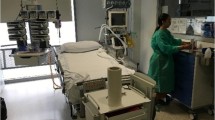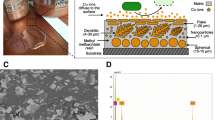Abstract
The use of copper for reducing nosocomial infections has been carried out in the Intensive Care Unit (ICU) by replacing some objects generally made of stainless steel or other materials with solid pieces of copper. The authors’ proposal consists of introducing copper in a “lamina + adhesive” format. This proposal has been tested in an ICU at the Ceuta Hospital. It has been found to provide an equally efficient solution than the usual “solid” format, but with sustainable use of copper, which is a high-cost and limited resource. After that intervention, some improvements are also proposed: a standardization of the pieces chosen to cover with a lamina of copper for saving material; and another method of replacement aiming to lower the time that the ICU cannot be used. To ensure that the proposed bonding method is harmless to human health and the adhesive does not interfere with the indoor environment by releasing toxic chemicals, the “lamina + adhesive” sheet has been further tested. The results and proposals are briefly shown.
Access provided by Autonomous University of Puebla. Download conference paper PDF
Similar content being viewed by others
Keywords
1 Introduction
The biocidal property of copper has been used by man for thousands of years. However, copper was not certified as a biocide by the United States Environmental Protection Agency (EPA) until 2008, after running laboratory and hospital tests [1].
This property is superficial, and the simple contact of the surface with a variety of pathogens inhibits its growth and reproduction [2], preventing them from spreading through the rest of the nearby surfaces [3]. For this reason, copper is an ideal material for hospital environments, especially in areas hosting patients with immunological problems, mainly the ICU.
The use of copper as a biocide in contact surfaces in hospitals has been used in a format that will be called “solid” since they are solid elements [1]. To make more efficient and sustainable use of the metal, we proposed a format that will be called “lamina + adhesive.”
Although this format “lamina + adhesive” has previously been applied by the author [4], the implementation methodology [4] has been reviewed. The emitted volatiles of the lamina + adhesive used in Ceuta have also been analyzed, because our proposal for reducing the bacterial load in a space-saving copper needs an adhesive, and this solution must not interfere with the health of the ICU patients.
2 Settings and Methods
As the time that an ICU can be out of order must be minimized, the methodology of the previous study made by the author in Ceuta will be analyzed focusing on the time spent during the customized intervention: the time spent in measurements, in designing and manufacturing the pieces, adding the time in the ICU for coating the selected objects with the customized moulds for each one of them.
Furthermore, the “lamina + adhesive” copper used in Ceuta will be analyzed to study the volatiles emitted by the adhesive and the film protector. Tubes with TENAX absorption will be introduced in sealed glass reactors. Two sets of reactors are prepared according to Fig. 1. To incubate in a stove at 29° for 72 days.
3 Results
3.1 Analysis of the Ceuta Study Results
The Ceuta ICU was described by photographs sent via email to the author. It took one week to carry out the previous analysis and select the objects to work with. Once in Ceuta, the author proceeded to design individual patterns for each object. These patterns were corrected and adjusted in the ICU, making an entry for 2 h to check the measurements.
A cutting plotter was used for most of the pieces, except a few that needed a manual cutting depending on their shape. Before cutting, the adhesive copper foil was covered with a protective film facilitating the cutting and measurements on the copper sheet. This protection foil is also analyzed in the study of volatiles.
The pieces were catalogued and ordered to be sorted out separately, allowing an efficient admission to the ICU to adhere to the objects. This stage took at least three hours.
It was found that the light switch was one of the most dangerous points. The measurement with luminometer 3 M Biotrace® UNI-LITE NG2 that was initially obtained in the switch was 1672 URL (Relative unit of light). After having covered the switch with a lamina of copper, the measurement obtained after 5 weeks was 41 URL. The complete description of the experiment performed is described in reference 4.
-
Once the measurement process was completed the material was removed.
3.2 Volatiles Study Result
The TENAX tubes have been analyzed using thermal desorption followed by gas chromatography analysis with mass spectrometry detector. After qualitative analysis using patterns and identification through the NIST mass library, more than 120 compounds were identified.
The measurements of the compounds found in the protective film are lower than the measurements of the compounds found in copper. It was observed that the copper lamina has emitted much more trichloroethylene and Ethyl-Hexanol than the protective film.
-
Aromatic compounds, aldehydes, and siloxanes have been identified in indoor air environments.
-
3-Isopropylbenzaldehyde has been found only in the Cu sheet. This compound is a volatile terpenoid and is known for its insecticidal activity.
-
It is striking to find benzoquinone; which is a compound used as an antiseptic in addition to other antibacterial applications.
4 Discussion
It would seem that the time used for the intervention of an ICU is highly dependent on the number and shape of the objects involved. This is considered the first result of the analysis of the methodology used in Ceuta.
Introducing copper laminas into the entire ICU seems to be a long-term task. This is explained by the variety of brands and models of the objects at hand, although they are standardized.
It was also observed that the useful life of the covering material depends on the use that is given to the object. So if the intervention made in the objects would need an update, change of piece or maintenance the methodology is easy and cheap.
Although the results show the presence of volatile compounds, the concentrations found are not significant according to Professional exposure limit for chemical agents in Spain of the National Institute for Safety Health and Welfare at Work [5]. This is the start of the following question: How much is admitted in a regular situation? And in the case of hospital ICUs where people with immune deficiency problems are being treated, it makes us think, could the exposure to this volatiles’ interfere with their recovery?
5 Conclusions
The purpose of this study is to improve the alternative proposal use of “copper lamina + adhesive” suggested for using less copper volume than the one used nowadays in hospital-interventions with “solid” copper. Achieving use efficiency requires a product and a technique that adapts to different scenarios and objects of possible interventions for saving material and also saving time in the start-up, thus achieving an economical use of material and time.
It is necessary to further investigate how different copper lamina products adapt to different scenarios and objects of possible interventions for achieving a rational use of the material. It is also concluded that the adhesive solution and the technique used must be “clean,” without interfering with the indoor environment. Although the lamina solution answers to the limits established by the Institute for Safety Health and Welfare at Work, more criteria should be proposed not to put the health of the ICU patients at risk.
References
Antimicrobial Copper Homepage. https://www.antimicrobialcopper.org, last accessed 2019/05/18
Salgado, C.D., Sepkowitz, K.A., John, J.F., Cantey, J.R., Attaway, H.H., Freeman, K.D., Sharpe, P.A., Michels, H.T., Schmidt, M.G.: Copper surfaces reduce the rate of healthcare-acquired infections in the intensive care unit. Infect. Control Hosp. Epidemiol. 34(5), 479–486 (2013)
Casey, A.L., Adams, D., Karpanen, T.J., Lambert, P.A., Cookson, B.D., Nightingale, P., Nightingale, P., Miruszenko, L., Shillam, R., Christian, P., Elliott, T.S.: Role of copper in reducing hospital environment contamination. J. Hosp. Infect. 74(1), 72–77 (2010)
Aillón, P., Acha, C., Domínguez, J.M.: Materiales e innovación en arquitectura sanitaria: cobre, barrera antibacteriana para espacios sanitarios. Anales de Edificación 3(3), 55–61 (2017)
Gobierno de España, Ministerio de Empleo y Seguridad social. Instituto Nacional de Seguridad, Salud y Bienestar en el trabajo.Límites de exposición professional para agentes químicos en España 2018 (2018)
Acknowledgements
We give thanks to Dr. Benigno Sánchez and Juan Gilaranz for the tests done at CIEMAT facilities.
Author information
Authors and Affiliations
Corresponding author
Editor information
Editors and Affiliations
Rights and permissions
Copyright information
© 2021 The Editor(s) (if applicable) and The Author(s), under exclusive license to Springer Nature Switzerland AG
About this paper
Cite this paper
Aillón, P., Parga, B. (2021). An Improved Proposal for Using Laminar Copper as a Biocidal Material in Hospitals in Touch Surfaces: A Study on Volatiles. In: Ksibi, M., et al. Recent Advances in Environmental Science from the Euro-Mediterranean and Surrounding Regions (2nd Edition). EMCEI 2019. Environmental Science and Engineering(). Springer, Cham. https://doi.org/10.1007/978-3-030-51210-1_362
Download citation
DOI: https://doi.org/10.1007/978-3-030-51210-1_362
Published:
Publisher Name: Springer, Cham
Print ISBN: 978-3-030-51209-5
Online ISBN: 978-3-030-51210-1
eBook Packages: Earth and Environmental ScienceEarth and Environmental Science (R0)





